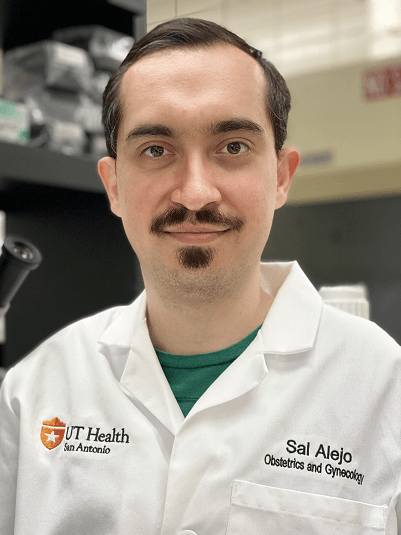Glioblastoma-impacted mice lived longer when treated with combination of molecule drug and chemotherapy agent
Contact: Will Sansom, 210-567-2579, sansom@uthscsa.edu
SAN ANTONIO (May 17, 2023) — Glioblastoma (GBM), a highly devastating brain tumor, has long posed challenges as effective treatments have remained elusive. Despite responding initially to treatment, GBM patients often experience therapy resistance leading to low long-term survival rates, with only 7.2% of patients surviving beyond five years.
Researchers at the Mays Cancer Center and Department of Obstetrics and Gynecology at The University of Texas Health Science Center at San Antonio have made significant progress in studying a promising new molecule that inhibits GBM tumors’ ability to repair themselves. Published in the prestigious journal Neuro-Oncology earlier this year, the study demonstrated that mice receiving this novel therapy in combination with chemotherapy showed extended survival compared to those receiving a single drug alone.


The molecule, known as NCD38, targets a specific subset of GBM cells called glioma stem cells. By disrupting their highly efficient DNA repair activity, NCD38 offers new possibilities for treatment. “Glioma stem cells are notoriously difficult to treat,” said Gangadhara Sareddy, PhD, corresponding author of the study and associate professor of obstetrics and gynecology in the health science center’s Joe R. and Teresa Lozano Long School of Medicine. Sareddy is also an investigator with the Mays Cancer Center, one of the four National Cancer Institute-Designated Cancer Centers in Texas.
Chemotherapy and radiation primarily damage the DNA of glioblastoma tumor cells, slowing tumor growth. However, glioma stem cells possess an elevated ability to repair this DNA damage, contributing to treatment resistance. NCD38 inhibits an enzyme called Lysine-Specific Histone Demethylase 1A (KDM1A), which plays a significant role in DNA repair within glioblastoma. “This enzyme is highly expressed in glioblastoma, and patients with elevated KDM1A expression tend to exhibit poorer overall survival,” Sareddy explained.
Enhanced survival
The study involved implanting GBM tumors into mice, followed by randomization into treatment groups. The mice in the treatment groups were assigned to receive either NCD38, the chemotherapy drug temozolomide, or a combination of both. A control group received a nonactive placebo. The mice receiving the combination of NCD38 and temozolomide demonstrated the longest survival rates. By inhibiting KDM1A activity and interfering with the cancer’s DNA repair, NCD38 enhanced the cancer-killing effects of temozolomide. “While mice in the non-treatment group succumbed to GBM within two to three weeks of implantation, those in the combination therapy group—NCD38 with temozolomide—survived four to five weeks,” Sareddy said.
New paradigms
While the study is yet to be conducted in humans, the potential benefits observed in mice could translate into significant survival improvements of two to three years for patients. “Identifying mechanisms that regulate DNA repair in glioma stem cells may unveil new paradigms to curb GBM growth and recurrence, ultimately improving patient outcomes,” noted lead author Salvador Alejo, a medical student in the South Texas Medical Scientist Training Program at The University of Texas Health Science Center at San Antonio. His research focused on this topic.
Further studies are needed to evaluate the safety and efficacy of this treatment strategy. Nonetheless, promising results from this study provide hope for developing new strategies to combat GBM treatment resistance and pave the way for enhanced patient care.
Acknowledgments
Funding was from the National Institutes of Health (NS106173-01A1 to Gangadhara Sareddy, CA269866 to Ratna K. Vadlamudi, GM113896 to Salvador Alejo, TR002647 to Salvador Alejo, T32CA148724 to Jessica D. Johnson, CA054174 and 1S10OD021805-01); the Max and Minnie Tomerlin Voelcker Fund (to Gangadhara Sareddy); and the Cancer Prevention and Research Institute of Texas (RP160732).
All animal experiments were conducted according to institutional guidelines after obtaining approval of the health science center’s Institutional Animal Care and Use Committee.
Lysine-specific histone demethylase 1A (KDM1A/LSD1) inhibition attenuates DNA double-strand break repair and augments the efficacy of temozolomide in glioblastoma
Salvador Alejo, Bridgitte E Palacios, Prabhakar Pitta Venkata, Yi He, Wenjing Li, Jessica D Johnson, Yihong Chen, Sridharan Jayamohan, Uday P Pratap, Kyra Clarke, Yi Zou, Yingli Lv, Korri Weldon, Suryavathi Viswanadhapalli, Zhao Lai, Zhenqing Ye, Yidong Chen, Andrea R Gilbert, Takayoshi Suzuki, Rajeshwar R Tekmal, Weixing Zhao, Siyuan Zheng, Ratna K Vadlamudi, Andrew J Brenner, Gangadhara R Sareddy
First published: Jan. 18, 2023, Neuro-Oncology
https://doi.org/10.1093/neuonc/noad018
The University of Texas Health Science Center at San Antonio (UT Health San Antonio) is one of the country’s leading health science universities and is designated as a Hispanic-Serving Institution by the U.S. Department of Education. With missions of teaching, research, patient care and community engagement, its schools of medicine, nursing, dentistry, health professions and graduate biomedical sciences have graduated more than 41,100 alumni who are leading change, advancing their fields and renewing hope for patients and their families throughout South Texas and the world. To learn about the many ways “We make lives better®,” visit UTHealthSA.org.
Stay connected with The University of Texas Health Science Center at San Antonio on Facebook, Twitter, LinkedIn, Instagram and YouTube.
The Mays Cancer Center, home to UT Health San Antonio MD Anderson Cancer Center, is one of only four National Cancer Institute-designated Cancer Centers in Texas. The Mays Cancer Center provides leading-edge cancer care, propels innovative cancer research and educates the next generation of leaders to end cancer in South Texas. To learn more, visit www.UTHealthSAMDAnderson.org.
Stay connected with the Mays Cancer Center on Facebook, Twitter, LinkedIn, Instagram and YouTube.
The Department of Obstetrics and Gynecology in the Joe R. and Teresa Lozano Long School of Medicine at the UT Health Science Center San Antonio is developing the next generation of leaders in academic obstetrics and gynecology, conducting research leading to advances in the health care of women, delivering excellent medical care to the women of San Antonio and South Texas, and participating in the continuing medical education of family physicians and obstetrician gynecologists.


